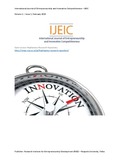| dc.description.abstract | Introduction: There is substantial growth and employment of pattering methods in statistics,
although a direct comparison of multivariate methods in group/cluster identification in the field of
Consumer Behavior in relation to Perceived Risk of e-Services Adoption Intentions has not yet
been undertaken.
Objective: This study analyses two different statistical techniques: i.e Principal Components
Analysis (PCA) and Analysee Factorielle des Correspondances (AFC). The main objective is
to compare patterns derived from Principal Components Analysis (PCA) and Analysee
Factorielle des Correspondances (AFC) procedures with respect to the Perceived Risk relating
to the e-Services Adoption Intentions.
Design: A survey was carried out using a structured questionnaire for a sample of 335 adults,
customers of 125 Greek e-shops. These were conventionally approached by the Marketing
Laboratory of a major public University in Northern Greece. Information Seeking,
Information Sharing and Responsible Behavior subscales are related to the Perceived Risk of
e-Services Adoption Intentions. These subscales were measured by 25 items, rated on a
seven-point Likert scale.
Methods: The study focuses on the presentation of the two main types of clustering methods,
Principal Components Analysis (PCA) and Analysee Factorielle des Correspondances (AFC).
Results: PCA’s results verified the construct validity of Perceived Risk of e-Services Adoption
Intentions multidimensional and hierarchical scale (Featherman & Pavlou, 2003). It
demonstrated the existence of seven Components, amongst which are the Financial Risk,
Performance Risk, Privacy Risk, Psychological Risk, Social Risk, Time Risk and Overall Risk.
Analysee Factorielle des Correspondances (AFC) revealed the first factorial axis which
expresses a negative attitude with respect to Privacy Risk, Performance Risk, Overall Risk
and Financial Risk on its left side and a positive attitude with respect to Privacy Risk,
Performance Risk and part of Overall Risk on its right side. Analysee Factorielle des
Correspondances (AFC) revealed the second factorial axis a neutral attitude to a part of the
conceptual construct Overall Risk, a neutral attitude to part of the conceptual construct
Financial Risk, to part of conceptual construct Performance Risk and to conceptual construct
named Privacy Risk. In addition, the second factorial axis detects those respondents who did
not have a crystal clear view as to whether they get Overall Service Quality also with respect
to their Purchase Intentions. The first factorial axis juxtaposes the extreme cases while the
second one, those in-between of the extreme ones.
On the first factorial level, at the first quadrant e +,e + 1 2 the group of respondents may be
distinguished by their positive attitude with respect to Privacy Risk, Performance Risk and
part of Overall Risk.
On the first factorial level, at the second quadrant e ,e + 2 1 the group of respondents may
be distinguished by their negative attitude with respect to Privacy Risk, Performance Risk,
Overall Risk and Financial Risk.
Finally, on the fourth factorial level and at the second quadrant 2 e ,e 1 the group of
respondents may be distinguished by their neutral attitude with respect to a part of the
conceptual construct Overall Risk, to a part of conceptual construct Financial Risk, to a part
of conceptual construct Performance Risk and to conceptual constructs Privacy Risk, Overall
Service Quality and their Purchase Intentions.
Psychological Risk and Social Risk seemed to be unimportant factors - their role in
determination of customers’ behavior is insignificant.
AFC’s results related to the customers psychological aspects regarding the specific scale
dimensions that determined their behaviour. | en_UK |

